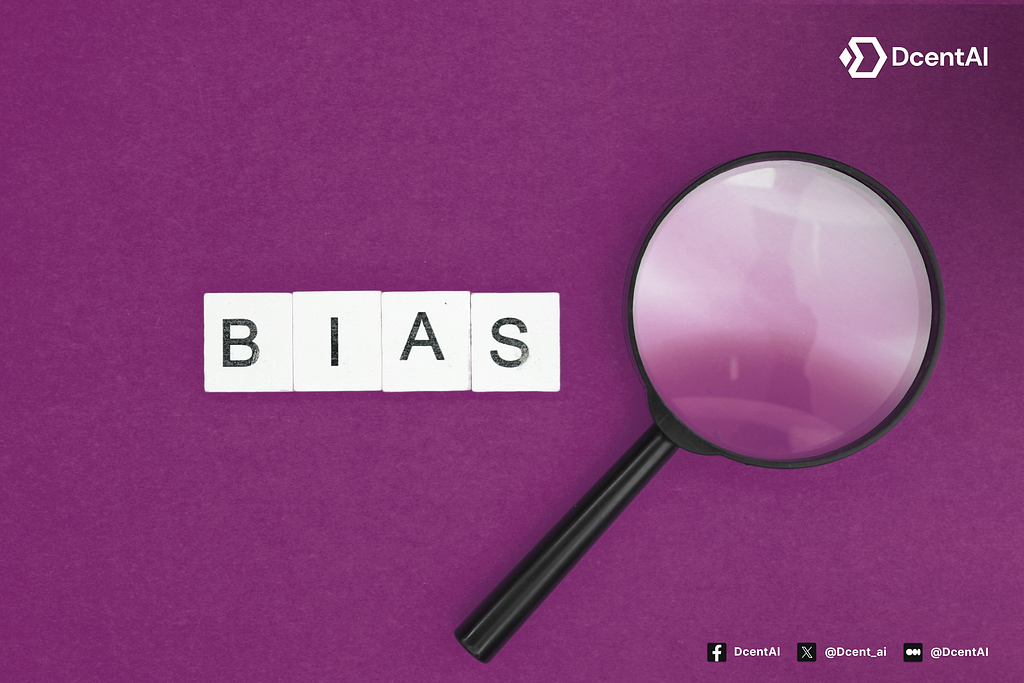Apple Dominates Wall Street’s AI Market, Samsung Not Far Behind.

AI bias is systemic favoritism in AI models caused by biased data or defective algorithms. Mitigating these biases is critical to ensuring accuracy, moral integrity, and fairness in AI applications. Addressing unjust AI systems can improve their trustworthiness and ensure their benefits are equally distributed among various user groups.
Mitigating bias poses particular problems and opportunities in decentralized AI models, such as those developed by DcentAI.Decentralization empowers transparency and collaboration, opening the way for more capable and comprehensive AI arrangements. In this article, we’ll see the significance of AI bias mitigation and the role of DcentAI in advancing unbiased AI advancement.
Sources of Bias in AIData bias occurs when the information used to train AI models does not reflect the population intended to serve. It can be caused by various circumstances, including historical disparities, underrepresentation of certain groups, and collection strategies that favor specific results. For example, if a facial recognition framework is generally trained on photos of light-skinned individuals, it may underperform on darker-skinned individuals, yielding one-sided and unjustifiable results.
Algorithmic biases arise from the design and execution of AI algorithms. Even if the data is impartial, the algorithms can create or magnify biases through information processing or decision-making methods. It may happen due to imperfect assumptions, oversights during development, or the use of execution metrics that do not consider fairness. For instance, an algorithm that estimates job performance might unintentionally show a preference for candidates from specific backgrounds if it depends on one-sided authentic hiring information.
Addressing these sources of bias is essential for developing fair and ethical AI systems. DcentAI leverages decentralized systems to upgrade transparency and collaborative endeavors to distinguish and mitigate data and algorithmic biases. By cultivating a different and comprehensive approach to AI advancement, DcentAI can construct AI models that are more precise, fair, and reflective of the diverse societies they serve.
Mitigation Strategies for AI BiasHere’s how AI biases can be mitigated:
Data DiversificationIt is imperative to consolidate data diversification in AI models to mitigate bias. This approach requires incorporating a broad range of demographic, geographic, and relevant data within the training dataset to represent the target population precisely. Effectively sourcing and integrating information from various sources and populations can successfully decrease the chances of underrepresentation and bias within the AI framework. For example, information in healthcare AI should include different age groups, ethnicities, and health conditions to guarantee equitable treatment proposals.
Algorithmic TransparencyAlgorithmic Transparency is another vital strategy for mitigating bias in AI. It entails making the inner workings of AI systems clear and accessible to stakeholders. Transparency empowers identifying and adjusting implicit biases within the algorithm’s design or decision-making process. Explainable AI (XAI) procedures help to clarify algorithmic decision pathways, permitting individuals to comprehend how conclusions are formed. This insight can lead to more informed decisions and modifications, lowering prejudice. Furthermore, transparency promotes accountability, as developers and organizations may be held accountable for the fairness and accuracy of their AI systems.
By integrating data variety and algorithmic openness, we can develop AI systems that are fairer and more just. DcentAI is dedicated to these values, utilizing decentralized structures to improve cooperation and transparency in AI advancement. DcentAI can build AI models that excel in performance and uphold ethical principles and equity across various uses through these initiatives.
Challenges and Solutions for Identifying Bias in AI
Here are the challenges and solutions for identifying bias in AI:
Challenges:- Complexity of Bias Sources: AI biases come from various sources such as algorithm design, model training, and data gathering. Due to this complexity, distinguishing the exact source of bias in the AI framework is problematic, as it can be complicated and subtle. A thorough examination is needed to determine all the relevant elements to locate the bias source.
- Lack of Diverse Data: Many AI models are trained on insufficient diversity datasets, which may provide biased results. Underrepresentation of particular populations in training data may lead to AI systems ineffectively performing for this group, worsening the existing imbalances. Gathering representative and diverse data in specific places with historical data restrictions is hard.
- Opaque Algorithms: Many AI algorithms operate as black boxes, meaning humans do not easily understand their decision-making processes. This opacity makes it difficult to identify and rectify bias within the algorithm. Without transparency, stakeholders cannot assess whether an AI system makes fair and unbiased decisions.
- Comprehensive Bias Audits: Regular bias audits systematically evaluate AI models for potential biases. This process includes analyzing the training data, examining the algorithm’s decision-making process, and assessing the outcomes across different demographic groups. Bias audits help identify areas where bias may be present and provide insights for remediation.
- Data Diversification Efforts: Diligently acquiring and utilizing various datasets can help lessen the risk of bias. It involves working with numerous organizations, communities, and stakeholders to gather information reflecting different opinions and experiences. Ensuring underrepresented groups are included in training data will help AI systems be more fair.
- Implementing Explainable AI (XAI): Implementing XAI aims to increase the transparency of AI frameworks by giving transparent and valid reasons for decision-making forms. XAI is critical in identifying prejudiced tendencies within the algorithm’s decision-making, permitting developers to make necessary advancements. By increasing openness, XAI fosters confidence and responsibility in AI systems.
- Ethical AI Frameworks: Creating and adhering to ethical AI frameworks is essential for directing the development and deployment of AI systems. These architectures promote justice, accountability, and transparency and provide a set of rules for effectively identifying and addressing bias. Organizations can use these frameworks to verify that their AI systems follow ethical standards.
- Community Involvement: Collaborating with different communities and partners during AI development might give valuable insights into potential bias. Involving community members in information gathering, model assessment, and feedback channels ensures the AI framework meets each user’s requirements and concerns.

Here are some of the real-world examples of successful bias mitigation in AI:
Google’s AI Fairness ProgramGoogle has implemented various strategies to address bias in its AI systems. One prominent project is the creation of the What-If Tool, which allows developers to see and study how AI models make decisions. This application assists users in identifying and correcting biases in machine learning models by allowing them to test various situations and understand the impact of data modifications. Furthermore, Google has invested in research to improve the fairness of its search engines and picture recognition systems, resulting in more equitable outcomes for varied user groups.
IBM Watson’s Fairness ToolkitsIBM Watson has created a set of fairness toolkits designed to detect and mitigate bias in AI models. These tools include AI Fairness 360 and Adversarial Robustness 360, which are open-source resources for assessing and mitigating bias in AI systems. These toolkits include several measures and methods for determining fairness, allowing developers to eliminate biases in data and model results. IBM’s dedication to transparency and fairness has resulted in further inclusive AI solutions, especially in healthcare and financial services.
Microsoft’s FairlearnMicrosoft has presented Fairlearn, an open-source toolkit outlined to assist engineers in evaluating and progressing the fairness of their AI models. Fairlearn provides fairness appraisals and mitigation algorithms that empower developers to measure disparities in model performance over distinctive demographic groups. Microsoft allows organizations to create more equitable AI systems by offering tools to identify and address bias. This toolkit has been applied in various sectors, including hiring, lending, and healthcare, to ensure fairer decision-making processes.
Compass and Fairness in Criminal JusticeThe COMPAS (Correctional Offender Management Profiling for Alternative Sanctions) system, which is utilized for risk assessment in the criminal court system, has been scrutinized for possible racial bias. Researchers and developers introduced fairness measures to address these concerns, such as bias audits and algorithm changes. These efforts sought to guarantee that risk assessments were objective and did not disproportionately affect specific racial groups. The continuous effort to improve fairness in COMPAS illustrates the significance of openness and accountability in AI systems used for vital decision-making.
Final WordsThe need to mitigate bias in AI is crucial to ensure that AI frameworks are reliable, fair, and just. Decentralized AI models have been gaining traction recently, and the need to eliminate both algorithmic and data must not be overlooked. Date diversification and algorithmic transparency are effective reductions to ensure unbiased AI solutions.
Decentralized AI networks like DcentAI can develop more inclusive and reliable AI models by actively discovering and correcting biases.This dedication to justice boosts the legitimacy of AI systems and promotes innovation and confidence within the AI community. As AI continues to change numerous industries, emphasizing bias reduction will be critical to realizing its potential for beneficial societal effects.
To learn more about DcentAI, visit our Facebook and X accounts.Become a pioneer of DcentAI community!AI Bias Mitigation: Addressing and Reducing Bias in Decentralized AI Models was originally published in Coinmonks on Medium, where people are continuing the conversation by highlighting and responding to this story.
